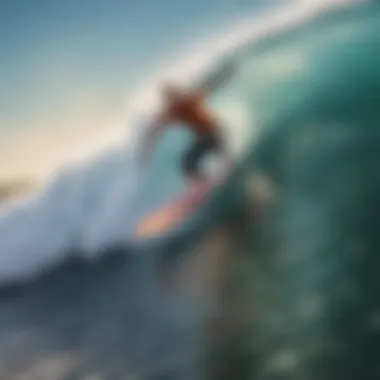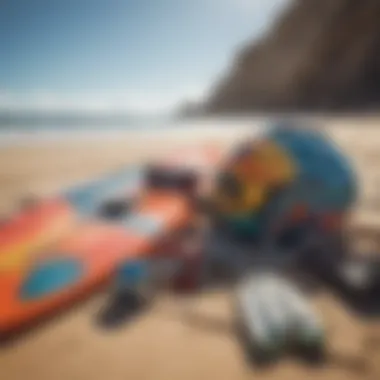Exploring Local Surf Culture: Community and Craft


Intro
Surfing isn’t just about riding the waves; it’s a whole lifestyle that blends community ties and cultural expressions. Each locale carries its own flavor of surfing—shaped by the surfers who catch the waves, the gear they choose, and the environments they navigate. Understanding the local surf scene means peeling back the layers of each coastal community and discovering what makes their surf culture distinct, yet intertwined with the global narrative.
Local practices range from the types of surfboards favored by surfers to the specific techniques honed in local waters. Culture plays its part as well, influenced heavily by geography, history, and the surfers themselves. This article dives into the key elements that form the backbone of local surfing communities, scrutinizing the relationships forged on the beaches and the craft of surfing itself. Surfers from all walks of life come together with shared passions, fostering a sense of belonging and camaraderie as they tackle the ocean's unpredictable rhythm. Whether you ride shortboards in California or longboards in Hawaii, each region tells a story through its waves.
From environmental factors that dictate surf conditions to the technology behind surfboards, this exploration aims to enrich your understanding of the myriad ways locality shapes these experiences.
As we journey through various aspects of the surf scene, we will facilitate a deeper appreciation for the community's vibrant cultures, and the unique gear essential for enthusiasts navigating through their surfing adventures. So grab your board and let’s paddle into the heart of local surf cultures!
Prelude to Local Surf Culture
Understanding local surf culture is akin to observing a delicate dance performed on the waves. Each surfer brings a unique style, crafted over time by not just their skill but the influences of their town, their local beaches, and the shared ethos of their community. Local surfing is more than just a pastime; it embodies identity, tradition, and connection among enthusiasts. This section aims to unpack these layers, revealing why the local surf culture is crucial not merely as a hobby but as a fundamental aspect of many coastal lives.
Defining Local Surfing
When we talk about local surfing, it’s not just about riding waves; it’s about a mindset and an experience shaped by the environment and culture surrounding it. Local surfing can be defined as an activity practiced by a community, influenced heavily by regional characteristics. For example, the vibe of a small town surf spot in California is starkly different from that of a bustling beach in Florida—the waves, weather, and even the expectations of fellow surfers shape the culture.
The characteristics of local surfing can include:
- Community Bonding: Surfers often gather, swapping tips and sharing stories, which fosters camaraderie and a supportive network.
- Cultural Traditions: Each location has its own rituals, from morning sessions reserved for the locals to spontaneous beach barbecues.
- Environmental Stewardship: Local surfers frequently take on the role of guardians of their beaches, advocating for preservation and ecological responsibility.
Emphasizing this defines the surfing experience as unique and profoundly rooted in personal connections and communal values. The local surf scene isn't just about the sport; it’s about belonging and identity.
The Significance of Place in Surfing
The phrase "location, location, location" holds weight in surfing as much as in real estate. The physical geography dictates the quality of waves and the overall surfing experience, serving as a backdrop for the local culture. This connection to place infuses local surfing with purpose and identity.
Specific factors that highlight the significance of place include:
- Wave Types and Formation: Local conditions affect surf spots. For instance, reefs create powerful waves, while sandy shores can lead to gentler swells, attracting different types of surfers.
- Cultural Heritage: Each surfing location has its own stories, legends, and histories that enrich the experience for those riding the waves. Surfing in Hawaii, for example, intertwines with ancient Hawaiian traditions, adding depth to each ride.
- Connection to Nature: Surfers develop a relationship with the ocean, often becoming advocates for environmental protection and sustainability due to their intimate knowledge of local ecosystems.
"Surfing is not just about the wave; it's about the connection between the water, the land, and the people who cherish it."
Geographic Influences on Local Surf Scenes
Understanding the geographic influences on local surf scenes is like peeling back the layers of an onion. Each layer reveals how the coastlines, weather patterns, and even the local environment shape the experience for surfers. This section will uncover the elements that make surfing not just a sport, but a deeply rooted part of the fabric of the community. From the signature waves of a region to the seasonal shifts that dictate when the surf is at its best, these geographic factors are integral to the identity of local surf culture.
Coastal Landscapes and Wave Formation
The relationship between coastal topography and wave dynamics can set the stage for a surfer's entire experience. Each beach is a canvas painted with a unique landscape, affecting how waves break and roll toward the shore. For instance, in regions where the coastline juts out and creates coves, like those found in California, surfers might experience more refined and predictable waves.
Conversely, in areas with open coastlines, such as the beaches in Florida, the waves can be more turbulent, offering unpredictable challenges.
Moreover, underwater features, like reefs or sandbars, play a crucial role in wave formation. A submerged reef can transform a typical wave into a barrel, creating the ultimate thrill for any rider. As local surfers familiarize themselves with these features, they can craft their strategies, leading to a unique community in each surf spot.
Climate and Seasonal Variations
Climate acts as the silent conductor, orchestrating the rhythm of the surf seasons. Each local surf scene has its preferred time of year, dictated by climatic conditions that vary by region. Surfers in places like Hawaii look forward to winter swells, which can lead to monumental wave heights, while those in Europe might cherish late summer's favorable wind conditions.
These seasonal variations impact not just the waves but also the community's overall vibe. It’s akin to a festival where the surfers become part of a larger celebration when conditions are right. For example:


- Winter months attract surf competitions that showcase local talent.
- Summer often brings families and casual surfers to the beaches, potentially changing the atmosphere and surf etiquette.
Surfers must learn to adapt, understanding not just their preferences, but also how climate influences the local surfing community.
Environmental Impact of Surfing
Surfing coexists with the environment, and this relationship demands careful examination. Environmental factors such as ocean health, pollution levels, and coastal degradation can significantly affect surfing conditions. If a beach is littered with debris or the coral reefs are dying, the surfing experience diminishes for everyone involved. Local surfers increasingly understand that caring for their environment is essential not just for their enjoyment but also for the legacy of their sport.
"We don't just ride waves; we are part of the environment. Protecting it is protecting our surf culture."
— A devoted local surfer
This awareness has fostered a climate where surfers engage in community-led initiatives, such as beach clean-ups and advocacy for sustainable practices. Protecting their local waters becomes not just a mission; it's ingrained in surfing culture itself. By doing so, they ensure that the waves will continue rolling in for future generations, maintaining that rich tradition and connection to their coastal geography.
The Surfboard: A Local Craft
The surfboard stands not just as a tool for riding waves but as a symbol of the intricate relationship between surfers and their local culture. It matters hugely—beyond simply a ride on the water, the surfboard reflects the ingenuity and artistry of local craftsmen. Surfboards have become part of the identity demanded by the ocean and the community it fosters, speaking volumes about the surfers who ride them.
Different regions often yield varieties of surfboards that cater to local wave conditions and preferences. Understanding the materials and techniques used in local manufacturing gives a clearer picture of how surfers fuse personal expression with practicality. The craftsmanship level speaks to the surfer’s passion and commitment toward their craft, making it an essential topic in the exploration of local surf culture.
Materials and Techniques in Local Manufacturing
Crafting a surfboard is no small feat; it takes a good eye and a steady hand to create something that meets the demands of the ocean. Most boards start with a foam core, often polystyrene or polyurethane, which provides the necessary buoyancy. The choice of materials significantly influences the final product's performance and durability.
With the evolving understanding of environmental impacts, many local shapers are turning to sustainable materials as well. Bamboo, for example, is gaining traction in the industry. It is lightweight yet strong, making it a viable alternative for eco-conscious surfers. Furthermore, epoxy resins are becoming increasingly popular due to their low volatile organic compound emissions, which benefits both surfers and the environment.
Techniques employed in surfboard crafting can vary markedly between locals, reflecting not only personal styles but also traditions passed down through generations. From hand shaping to machine-cut precision, these techniques contribute to a board’s unique feel. Some surfers even favor customized dimensions tailored to their size, preferences, and local wave conditions.
"The perfect surfboard is not just about the ride; it carries the stories and styles of its maker and rider."
Customization Trends Among Local Surfers
As the surf culture evolves, so does the idea of what the ideal surfboard can be. Customization has surged in popularity, with many surfers recognizing the value in boards that fit their distinct style and needs. The local surf shop has become somewhat of a design hub, where surfers work closely with craftspeople to create their dream board.
The styles often range from colorful art to specific shapes, catering to all kinds of riding styles. For instance, the traditional longboard remains a popular choice among more experienced surfers who appreciate its stability and smooth rides in smaller waves. Conversely, shortboards appeal to those looking for agility and speed.
Local shapers are constantly pushing boundaries, experimenting with hybrid designs that blend various elements from different types of boards. And this customization isn’t just about aesthetics; it also plays a functional role. Adjustments can lead to enhanced performance, such as better paddling ability or improved maneuverability during rides.
The community aspect of this customization trend is vital too. Surfers often collaborate in groups to share ideas, fostering a vibrant dialogue that builds relationships within the local surf community.
In sum, surfboards are more than mere objects in local surfing culture; they are a craft that embodies tradition, skill, and personal connection to the waves and the local environment.
Community Dynamics in Surfing
The heart and soul of any surf scene lie within its community dynamics. This topic captures the interactions, relationships, and shared experiences that shape the essence of local surfing culture. As surfers peruse the waves together, friendships form and bonds strengthen, giving rise to a unique collective identity.
A close-knit surfing community fosters camaraderie, where experienced surfers can impart invaluable knowledge to newcomers. This transference of skills not only elevates the sport but reinforces the sense of belonging that characterizes surf communities. Mentorship, in many cases, becomes a rite of passage, helping to propel the culture forward while maintaining its roots.
In addition to this mentorship, the support network built among surfers facilitates collaboration in various areas, from creating sustainability initiatives to organizing local events. Such interactions also make a significant impact on the local surf economy, extending benefits that help sustain surf shops, schools, and competitions.
Understanding community dynamics is crucial for appreciating how each local surf scene is not just a collection of individuals but a vibrant ecosystem that thrives on interaction and shared passion. Whether it's launching into the surf at dawn or gathering around a bonfire after a day on the waves, these moments become the fabric of the community and play a pivotal role in shaping its future.
The Role of Local Surf Shops
Local surf shops are more than just retail spaces - they are communal hubs that breathe life into the surf culture. These shops symbolize the heart of the community, serving as meeting points where surfers gather to share stories and whipping through colorful merchandise or discussing the best conditions.


Within these walls, you can find:
- A breadth of local knowledge, from surf conditions to upcoming activities that keep all enthusiasts informed.
- Custom surfboards and specific gear tailored to the demands of the local waters, enhancing both performance and safety.
- Workshops and events often arranged to bring together those who have a passion for surfing, reinforcing the community's bonds.
Moreover, the support that local surf shops provide can empower surfers to make eco-friendly gear choices, fostering a culture of sustainability and responsibility within the community. These connections help cultivate an atmosphere where surfers feel free to express their individuality while united under the shared experience of riding the same waves.
Events and Competitions: Building Community
Surf events and competitions serve as the lifeblood of many local surf scenes. These gatherings not only showcase talent but also strengthen community ties. They create platforms where surfers can meet, compete, and cheer each other on – binding them closer together in shared excitement.
Participating in local surf competitions offers a chance for:
- Skill development, as surfers receive constructive criticism from experienced judges and fellow competitors.
- Networking opportunities, allowing surfers to connect with others in the sport, all while enjoying the thrill of competitive spirit.
- Celebrating local talents, as communities rally around their representatives, fostering pride and mutual support.
These events often include music, food stalls, and surf-themed activities that elevate the surf scene into a community festival, where families and friends come to enjoy the waves beyond just the competition. This broader acceptance helps ground surfing culture into the everyday lives of varying demographic, creating a diverse yet unified local surf community.
Mentorship and Skill Development
In every local surf community, mentorship plays an integral role in the growth of both individuals and the collective culture. This relationship is essential as it acts as a conduit for knowledge, experience, and support. Surfing, like any other sport, has its complexities, and the guidance of seasoned surfers is invaluable.
Mentorship can manifest in numerous ways:
- Informal sessions: More seasoned surfers often hit the waves with newcomers, providing tips and encouragement in real-time, making learning a natural and enjoyable process.
- Skill workshops: Local surf shops might host workshops led by accomplished surfers, focusing on techniques, safety, and wave reading, all enhancing the development of aspiring surfers.
- Community initiatives: Mentorship can extend to environmental awareness practices such as beach clean-ups, where surfers learn the importance of preserving their playground while forming mentor-mentee relationships.
This focus on mentorship not only raises the skill levels within the community but also embeds values of support and camaraderie. Young surfers nurtured under the aegis of experienced locals are more likely to give back, ensuring that the cycle of learning, sharing, and growing within the surf community continues for generations to come.
Cultural Aspects of Local Surfing
Surfing is not merely a sport; it's a vibrant tapestry of community and culture woven intricately into the coastal way of life. Cultural aspects of local surfing play a pivotal role in defining the identity of surf communities. These traditions and influences lend a richness to the experience that transcends riding waves.
Traditions and Rituals in Surf Communities
In every local surf community, traditions breathe life into the daily routines of surfers. Observances can vary widely; you might witness a sunrise gathering where surfers perform a shared ritual of respect before they hit the waves. This could involve a moment of silence or a short prayer for safety and respect for the ocean. These practices are not just symbolic; they foster a sense of belonging and connection among participants. Each community develops its own customs, often passed down through generations, linking surfers to their coastal heritage.
Many surfers also participate in beach clean-ups or honor specific days to acknowledge environmental commitments. Such rituals strengthen bonds and remind all community members of their responsibility towards maintaining the coastal habitat they cherish.
Another prevalent tradition is the surf club gatherings where members share stories, techniques, and local lore, creating a living narrative that engulfs all in attendance. Learning how to surf from a local legend or participating in monthly meet-ups can be vital in constructing the fabric of surf culture.
Influence of Local Arts and Music
The aesthetic dimensions of local surfing are deeply influenced by the arts and music that resonate within each community. Many surf towns boast vibrant local arts scenes, with murals depicting ocean scenes and surf culture splashed across walls. These artworks not only tell the stories of surf heritage but also represent the unique perspectives of local artists, capturing the essence of their environment in ways that unite residents and visitors alike.
Local music often intertwines with surfing, creating soundtracks that reflect the lifestyle and ethos of the community. Live music gigs at beachfront bars can often become informal gatherings where surfers bond over shared experiences, anticipating the next big swell while tapping their feet to a catchy tune. Musical styles rooted in the community, such as reggae or surf rock, serve to complement the surfing lifestyle.
“Art is the most beautiful of all lies.” This quote emphasizes how essential local arts and music are to surfing culture. The creativity that flows from local artists expresses emotions that are often felt while riding waves.
Sustainability and Local Surfing
Sustainability holds a key role in defining the values and practices within local surfing communities. As the waves roll in and out, they remind surfers of a deeper obligation: the fragility of oceanic ecosystems and the pressing need for conservation. This section explores how local surf cultures intertwine with sustainability, emphasizing the benefits of responsible practices and community initiatives.
Conservation Efforts by Local Surfers
Local surfers are often the first line of defense for coastal environments. Across the globe, surf communities have banded together to promote conservation initiatives aimed at protecting the catchment areas that nourish wave formation. Some of the prominent conservation efforts include:


- Beach Clean-ups: Regularly organized events that bring surfers together to clean up beaches, ensuring they remain pristine and inviting.
- Awareness Campaigns: Initiatives to educate both surfers and the general public about the impact of litter and pollution on marine habitats.
- Habitat Restoration Projects: Collaborations with local environmental organizations to restore coastal dunes and wetlands, which are vital to surf breaks.
- Advocacy for Regulations: Many surfers lend their voices to advocacy efforts aimed at instituting marine protected areas, ensuring that surfing locales are safeguarded against destructive activities.
These actions create a sense of community ownership over local environments, where surfers realize that maintaining the coastline is as important as riding its waves.
Sustainable Practices in Surfing Gear
The surge in eco-consciousness within the surfing world has led to innovative approaches in the creation of gear. The following practices are becoming increasingly recognizable among surf enthusiasts:
- Eco-friendly Materials: Brands are shifting towards sustainable materials for surfboards, like bamboo, recycled plastics, and organic resins. For instance, using epoxy resins instead of traditional polyester can significantly reduce the environmental footprint.
- Durability Focus: Many local surf shops emphasize the long-lasting nature of their boards and accessories. A product that withstands time also prevents frequent replacements, reducing waste.
- Second-hand Markets: Local surfers often turn to buying or trading pre-owned boards and wetsuits. This not only saves money but also prevents the influx of new products, promoting a circular economy.
- Minimalist Gear: Surfing gear designed with simplicity in mind reduces material usage and promotes a cleaner, less cluttered approach to the sport. Less often is more, as they say.
Through these sustainable practices, local surfers are not just participants in a sport but custodians of their environment. They understand that a clean ocean contributes not only to better waves but also to healthier communities.
"One wave moves on to another, just like our responsibility towards the ocean. If we don’t care for it now, future generations will not be able to enjoy what we have."
Responsibility towards sustainability in surfing is not a trend but a movement that is gaining momentum within diverse surf communities. By embracing eco-friendly practices, through conservation and thoughtful gear production, they are crafting a narrative that reflects love for the ocean and the waves it brings.
Emerging Trends in Local Surf Communities
The landscape of local surfing is shifting. It’s not just about catching the perfect wave anymore; it's increasingly about the community. Emerging trends in surf culture reflect a growing recognition of inclusivity and the influence of technology. These shifts are reshaping how surfers engage with their sport and one another.
The Rise of Women in Local Surfing
Women have long been part of surfing, but only recently has their presence gained undeniable visibility. The rise of women in local surfing is not just a shift in numbers; it’s a cultural shift that challenges traditional norms. Beaches that were once male-dominated are seeing more women taking to the waters, showcasing their skills in competitions and bringing different perspectives to the scene.
This trend is marked by increasing representation in surf media, as more films and articles highlight female surfers' achievements. Organizations dedicated to empowering women, such as Girls Who Surf and the Women's Surf League, play a crucial role in this movement. They foster mentorship and promote events that are specifically designed for women, offering a platform where they can shine.
- Community Impact: Women surfers often create strong bonds and support networks, giving rise to a sense of community that wasn’t always apparent before.
- Skill Development: Initiatives focused on women help to normalize female participation in surfing, encouraging more girls to start surfing at a young age.
- Cultural Significance: As they gain visibility, women surfers influence discussions around body image, athleticism, and femininity in ways that resonate beyond just the sport.
Through this rise, the narrative surrounding local surf culture becomes richer and more diverse, promoting an environment where everyone feels welcome.
Technology’s Influence on Local Surfing
Another notable trend is the growing influence of technology in local surfing. It’s revolutionizing how surfers approach their craft and interacts with their environment. Not just in equipment but also in how surfers gather information and share experiences.
- Smart Boards: Surfboards integrated with sensors can now provide valuable data regarding wave patterns and performance metrics. This information enables surfers to refine their techniques, track their progress, and learn more about surf conditions.
- Social Media: Platforms like Instagram and TikTok have transformed how surfers connect. They can share their local spots, experiences, and tutorials in real time, expanding their community beyond geographical constraints.
- Surf Forecasting Apps: Applications that provide real-time updates on surf conditions have become indispensable for local surfers. They can check wave sizes, wind speeds, and tide information right from their pockets, ensuring they won't miss a swell.
These technological advances present both benefits and challenges. As the local surf scene continues to embrace technology, it blurs the lines between traditional skills and modern tools, reshaping what it means to be a surfer in today's world.
"Innovation in surfing is not only about technology; it’s about enhancing the experience and keeping the spirit of the sport alive."
Through the convergence of inclusivity and technology, local surf communities are evolving into more dynamic, diverse, and accessible spaces. This offers the chance for a vibrant future where every member can contribute to the culture and craft of surfing.
Ending: The Future of Local Surfing
As we ride the final wave of this exploration into the local surf scene, understanding the future trajectory of surfing communities becomes not just relevant, but essential. The shifts in environmental conditions, social dynamics, and technological innovations all weave a complex fabric that will determine how local surf cultures evolve.
Vision for Sustainable Surf Communities
It's clear that sustainability isn't just a buzzword; it's emerging as a vital element in the future of local surfing. The health of the ocean directly affects surf conditions and, consequently, the heart of local surf culture.
- Protection of Coastal Environments: Many surfers are becoming not just wave riders but also advocates for coastal preservation. Interest in initiatives that promote clean-ups and conservation projects is gaining traction. Engaging with local environmental groups can help communities mobilize efforts to protect their home breaks.
- Eco-Friendly Practices: From eco-conscious surfboard manufacturing processes to sustainable clothing brands, the shift towards greener practices is reshaping local surf culture. Surfers are beginning to recognize the value of gear made from recycled materials or surfboards crafted with sustainable wood. This is a step toward a circular economy within the surf industry, promoting longevity not just in equipment, but in the way surf communities relate to their environments.
- Education and Awareness: Delivering workshops on marine ecology and sustainability practices can raise awareness within the community. Knowledge about ocean health can empower surfers to be stewards of their local waters. Surf schools are also integrating such themes into their curriculums, emphasizing that part of being a good surfer is being a good guardian of the sea.
"The future of surfing is not just about riding the waves, it’s about protecting the playground we love."
Legacy and Continuity of Local Culture
As the tides of change continue to shape local surf communities, maintaining the integrity and essence of surf culture is paramount. With each generation, there's a passing down of knowledge, stories, and traditions that define what it means to be a local surfer.
- Mentorship Programs: Establishing programs that connect veterans with newcomers can enrich the surf experience. Veterans can pass on not just skills but also a sense of respect for local customs and etiquette. This practice strengthens bonds within the community and helps preserve the unique culture that characterizes local surfing.
- Cultural Events and Competitions: These gatherings create a shared sense of identity and belonging. They provide venues for local talent to shine and foster unity among surfers of different backgrounds. Such events often celebrate local art, music, and storytelling, making them much more than just surfing competitions.
- Documentation and Storytelling: Encourage local surfers to document their experiences through blogs or community platforms. Telling one's own story not only adds to the narrative of the local surf scene, but it also invites new voices and perspectives, ensuring a dynamic and inclusive culture.



